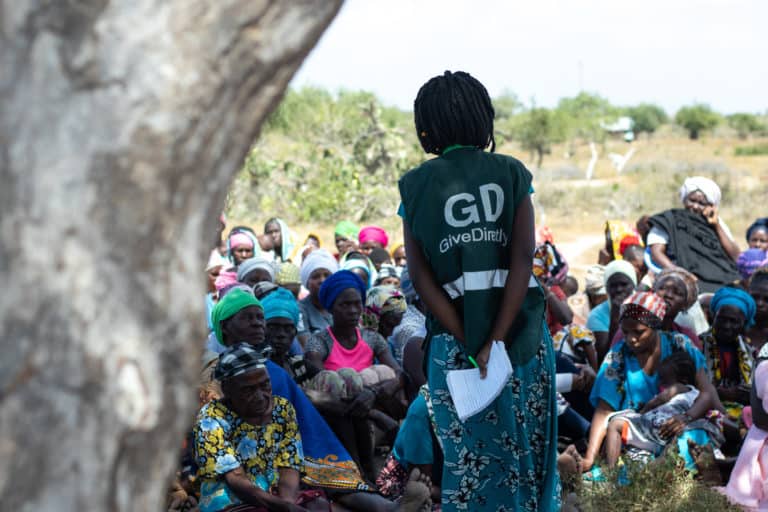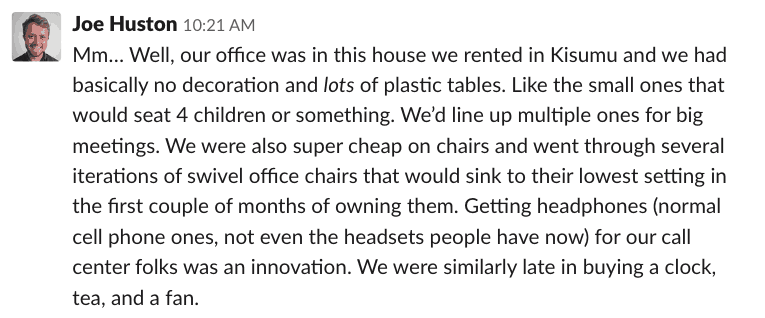For the last 10 years, GiveDirectly has held fast to the belief that we can best improve as an organization by staying radically transparent with our donors about what is going right and what is going wrong — and then replicate where applicable and pivot where necessary.
These are 10 impactful things we’ve gotten right and wrong over the last decade. From these wins and misses, we’ve gleaned important learnings to help guide us in better serving recipients.
#1 What we got right: Deciding to trust poor people.
Since we made the radically rational bet that people living in poverty would be better off deciding their own outcomes than aid organizations and donors thousands of miles away, GiveDirectly has not once wavered in its decision to trust people living in extreme poverty.
Over the last decade, GiveDirectly recipients have blown us away time and again by the ways in which they’ve chosen to invest their money: be it on pooling funds to pay a school teacher to tutor all the children in their village on Saturdays or investing in starting a motorcycle taxi business to shuttle other recipients to a nearby cashout center. One GiveDirectly recipient — William Owegi — even used his transfer to start a band, hiring seven other musicians plus four dancers, and using the band to generate income by playing paying gigs around their community. They released an album, which included an original track called the “GiveDirectly Theme Song.”
There are so many ways recipients have invested in themselves and their communities that we could have never predicted — and to this day we stand by the belief that we should not be in the business of making such predictions on behalf of the global poor.
#2 What we got wrong: Not initially holding community meetings.

GiveDirectly hosting a baraza (an introductory community meeting) in a village in Kenya.
Today, when we find an eligible village to deliver funds to, we begin by holding an introductory community meeting — called a “baraza” in most places we work — to explain how GiveDirectly works to the entire village. During our very first rounds of enrollment, we did not hold these introductory meetings and instead only met with village elders (today we do both: we still meet with elders before the baraza). We realized that, by hosting our own information sessions up front, we could avoid the spread of misinformation and use the opportunity to build trust with the entire community up front.
#3 What we got right: Putting basic income to the test.
Globally, the idea of a basic income is taking hold. Pilots are being run by governments and non-governmental organizations across the world, from Finland to Canada. When GiveDirectly launched a basic income study across 197 rural villages in Kenya, we jumpstarted what is — to this day — the largest experiment on basic income in the world. The study is not only delivering millions of dollars into the hands of 20,000 people, but also contributing valuable data to the conversation about what impact a reliable cash income can have on helping people improve their own circumstances. We’re thrilled to play a part in the debate.
#4 What we got wrong: Not realizing sooner that we should invest in call center tech.
Each country GiveDirectly works in has a local, in-country office equipped with a call center to field hotline calls and conduct follow-up check-ins with recipients who have been enrolled. The call center is one of the most important ways in which we provide top-notch customer service to recipients — they can expect to have any questions answered or complications addressed when they reach out to the call center.
In the early days, we relied on feature phones and Excel, but soon realized that we could meaningfully improve our ability to customize follow-up and provide high-quality case management if we upgraded our tech. GiveDirectly call centers track metrics such as call answer rate and drop rate, average answer time, talk time, pause time, and more. Optimizing our call centers aids us in improving our efficiency and ensures we deliver exceptional customer service to GiveDirectly recipients.
#5 What we got right: Opting to saturate entire villages instead of targeting specific households within them.
In 2017, we decided that — once we identified a village that met GiveDirectly’s eligibility criteria — we would transfer funds to every household in the community (i.e., we would “saturate” the community), as opposed to targeting only the very poorest families in that village.
Saturation allows us to move faster — increasing overall efficiency — and is clearer to explain to communities. Moreover, saturation ensures that we err toward errors of inclusion over errors of exclusion, reducing the likelihood of generating ill will in a community catalyzed by GiveDirectly’s work.
To this end, saturation will continue to remain our default enrollment method.
#6 What we got wrong: Waiting too long to grow the fundraising team.
During the early years, we focused primarily on building out systems and programs to most cost-effectively deliver dollars to recipients, consistently prioritizing operational excellence over fundraising. Over time, we’ve seen the value of investing in fundraising in parallel to scaling our operations.
By focusing a greater portion of our team’s time on raising more dollars for the poor, we can see higher return than if we had just focused on delivery efficiency alone. As a result of early prioritization, GiveDirectly now has the operational capacity to deliver $100M in 2020 — the only barrier to this milestone is fundraising. As an organization, we are built out to move more money than we are currently raising.
#7 What we got right: Scaling cash as a benchmark.
A question we encourage all donors to consider when they’re giving some form of aid is: “Will this aid do more good for someone than if I were to simply give them cash?” If the answer is unclear, we believe cash should be the default, as it is one of the most well-researched types of aid that exists today.
In partnership with USAID, GiveDirectly engaged in a study that helped establish the concept of the “cash benchmark” — the standard against which all other aid should be measured. GiveDirectly is also currently running four other cash benchmarking studies in partnership with USAID. We still have a long way to go in shifting the aid sector to consider cash the default that other interventions must outperform, but cash benchmarking moves the sector closer to that reality, ultimately pressuring the aid community to prioritize measured impact.
#8 What we got wrong: Taking for granted how explicit we needed to be in explaining unconditionality to recipients.
Unconditionality is an important tenet in GiveDirectly’s work, but we’ve come a long way in communicating this clearly to recipients.
As an example, in the early days GiveDirectly incorporated thatched roofs as a proxy for identifying poor villages (we now use census data and surveys that help us identify whether villages meet our eligibility criteria instead). As a result of our thatched roof targeting, we heard anecdotal reports that some recipients were under the impression that they’d been chosen to receive funds from GiveDirectly explicitly to upgrade their thatched roof to a tin roof, even though they were told that their cash transfer was unconditional.
We were able to catch this misunderstanding in recipient comprehension surveys, and experiment with new ways to communicate unconditionality. We now provide every enrolled recipient with a paper that has photographs depicting different ways past recipients have used funds. This visual resource helps recipients understand that their cash transfer can be spent on anything, and that spending decisions among past recipients vary widely. It’s worth noting that many recipients do still choose to spend their transfers on roofs.

A recipient, Stanley, who lives in a village in Kenya, just received his GiveDirectly transfer in May. This is his thatched roof home. He is building a larger home with a tin roof on his property using his GiveDirectly funds.

A collection of tin and thatched roofs seen from above in a village in Malawi.
#9 What we got right: Building out an internal audit team.
In 2015, GiveDirectly discovered an internally-coordinated fraud effort in our Uganda field office. The incident catalyzed the hiring of a new team: the internal audit (IA) team.
The GiveDirectly IA team is a group of individuals in each country who are completely firewalled from the rest of GiveDirectly field staff — they are tasked with investigating fraud across GiveDirectly programming. The main goal is to identify (or deter) any potential staff fraud, but the IA team also seeks to uncover any potential fraud by recipients, community members, mobile money agents, or government employees.
Most days, the IA team’s field interviews (of randomly selected or risk-flagged individuals) uncover nothing. However, the IA team has occasionally found instances of GiveDirectly staff members seeking kickbacks from recipients for enrollment in the program, or more powerful community members requiring recipients to share a portion of transfers with them. In addition, the IA team have led investigations in situations where we’ve received allegations against our team. Our IA colleagues are there to keep us honest about any times where we don’t put recipients first.
#10 What we got wrong: Sometimes we were a bit too scrappy.
GiveDirectly is scrappy — and always will be. Staying scrappy is a prerequisite to efficiency. But there have certainly been times where we were scrappy at the expense of team efficiency. We think GiveDirectly’s CFO (and one of GiveDirectly’s very first employees) summed it up best in describing our very first office in Kenya.

Over the last 10 years, we’ve developed a more sophisticated understanding of where to stay lean, and what investments are worth the return.
